_We may earn revenue from the products available on this page and participate in affiliate programs. Learn more ›
_
Air guns have become increasingly popular in recent years. Their quiet report means you can spend an afternoon plinking without disturbing the neighbors. And in a lot of areas, air rifles aren’t burdened by the same no-discharge ordinances that prohibit firearm use. But choose the right air gun can be a little daunting to the uninitiated, as terms like break-barrel, side-lever, and pre-charged pneumatic can sound foreign even to experienced hunters and shooters.
Don’t worry. It’s nothing you can figure out with a little help, and that’s what we’re here for. Below is everything you need to know to buy the best air gun for your needs.
The History of Air Guns
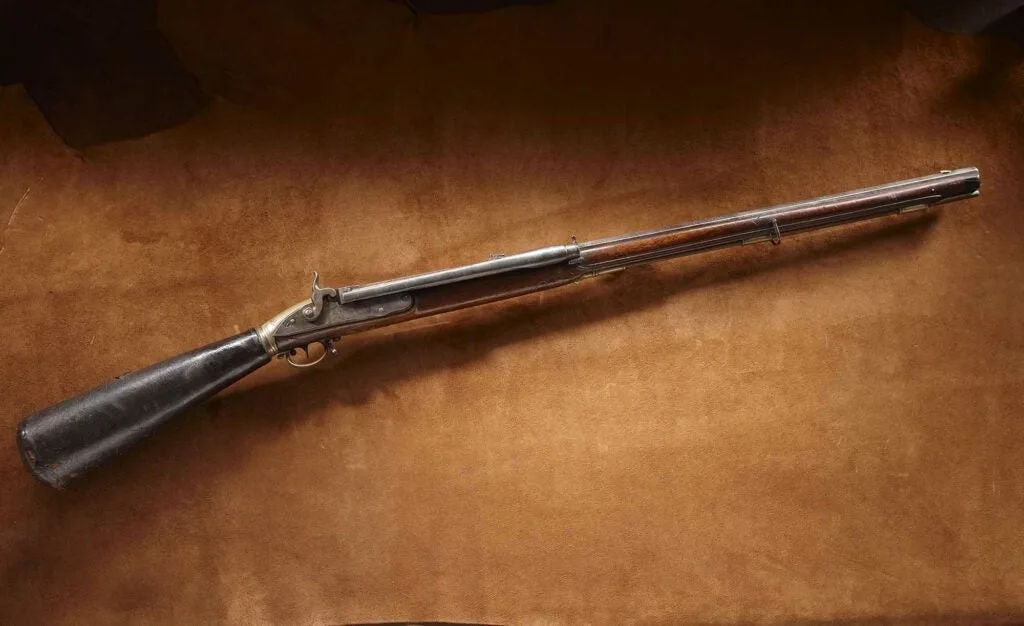
This Girandoni air rifle is nearly identical to the one used by Lewis and Clark. NRA Museums
It can’t hurt to know a little background info on what you’re out to buy, and as a bonus, the history of air guns happens to be pretty fascinating. Air guns have been around almost as long as their powder-burning counterparts. Lewis and Clark carried a .46-caliber air rifle on their trek to the Pacific way back in 1803. But by then, the Girardoni air rifle they packed had already seen 23 years of service with the Austrian army. Compared to contemporary blackpowder arms, it had a significantly higher rate of fire, much lower report, and didn’t produce a big plume of smoke that gave away their position.

The first Daisy air rifle, an all-metal design, was included as a premium with one of the company’s windmills. Daisy
Air guns wouldn’t really catch on in the New World, however, until the owner of a failing windmill company met with the inventor of an all-metal airgun. When shown the innovative rifle, one windmill executive remarked ‘It’s a Daisy.’ When sales of new air gun quickly eclipsed other goods, the company stopped production of windmills in 1895 and changed its name to the Daisy Manufacturing Company
. Daisy would go on to produce the Red Ryder No. 111 Model 40 BB carbine in 1940, named after a comic strip cowboy. Daisy sold about 6 million of them by 1953, despite a five-year hiatus in which the company produced goods needed for World War II. Other models of the Red Ryder have remained in more or less continuous production since, cementing air guns in American culture. Still, the majority of advancements in the air gun community came and still come from across the pond. With their firearm ownership so heavily regulated, Europeans turned to air guns to scratch their shooting itch.
Types of Air Gun Projectiles
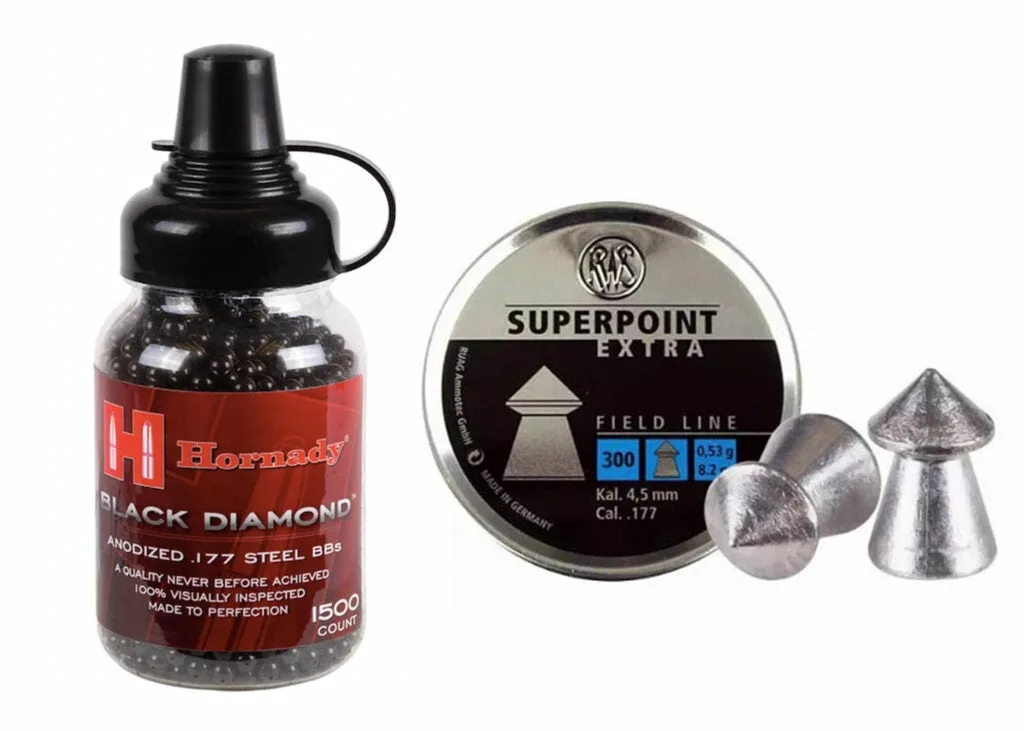
Hornady Black Diamond .177-caliber annodixed BBs and RWS Superpoint .177 Caliber pellets. Hornady and RWS
There are two main types of air gun projectiles: BBs and pellets. BBs are usually made from steel and are designed for smoothbore guns. The round projectiles are cheap to produce and buy but aren’t terribly accurate. And putting the hard metal projectiles through the rifled barrel of a pellet gun can cause damage and ruin accuracy.
The streamlined shape of pellets, on the other hand, produces greater accuracy, and like bullets, they come in a variety of shapes. Flat-point pellets and wadcutters are best suited for paper, tin cans, and reactive targets. Pointed pellets and hollow-points are ideal for hunting. Domed pellets lie somewhere in the middle, built for target use but suitable for taking game when pushed to 1,000 fps or more. Pellets were traditionally made from lead, but a variety of alloys have hit the market in the past couple decades. These are lighter, and therefore faster, than lead versions of the same silhouette. Just be aware that lighter projectiles don’t produce as much knockdown power.
Air Gun Calibers
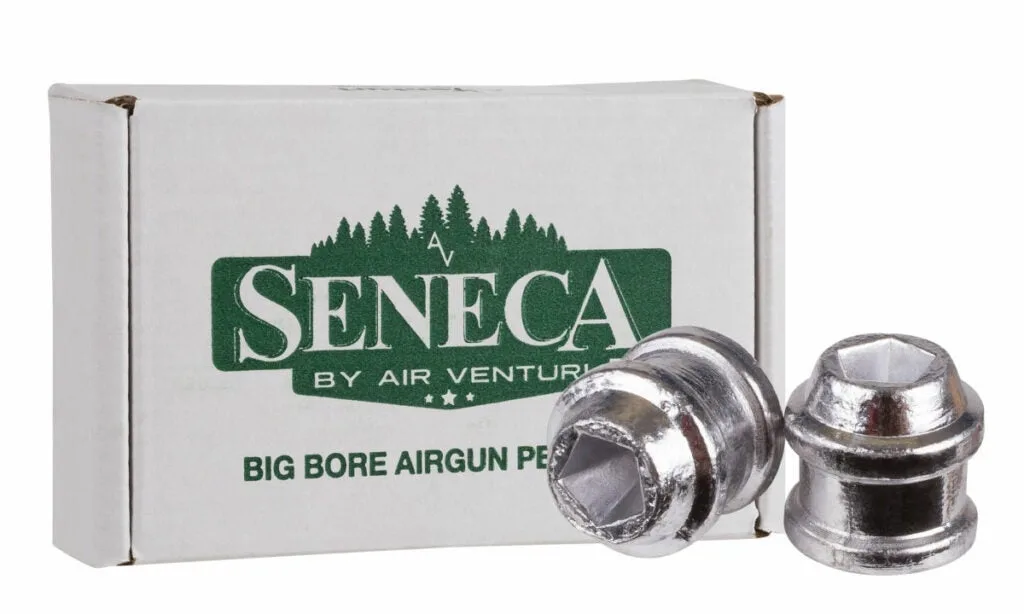
Air gun projectiles run the gambit from .17 caliber all the way up these gargantuan .50-caliber hollow points from Air Venturi. Air Venturi
BBs are .177 caliber, or 4.5mm. That’s probably still the most popular bore size here in the States, but others are rapidly gaining popularity as air gun hunting gathers steam. A serious air gun shop will carry rifles in .177, .20, .22, and .25. And if the store is located in an area where big-game hunting is legal, you’ll find pellets as large as .51 caliber, though .35 and .45 are probably the most prevalent for hog- and deer-size game. Just like centerfire bullets, the more mass a projectile has, the greater energy it can carry downrange with it. If you’re looking to pick starlings off, or go toe-to-toe with a big pile of cans, go ahead and reach for the .177. I’ve always been a fan of .20 caliber projectiles for hunting small game like rabbits and squirrels, but they can be difficult to find. A .22 caliber air rifle with enough oomph will take most small game with ease, so consider that a great starting point for a hunting set up. If you’ll also be clearing the barn of critters like raccoons every now and then, opt for .25 caliber.
Feet Per Second vs. Foot-Pounds for Air Guns
Air guns are often advertised using the maximum feet per second at which they are capable of propelling pellets. This can be a good way to compare them at a glance, but this number only tells half the story. To obtain these maximum speeds, manufacturers may use alloy pellets that weigh less than their lead counterparts and, in turn, move much faster. But a lighter projectile carries less energy, which translates to less knockdown power hitting the target. A standard-velocity .22LR produces around 100 foot-pounds of energy at the muzzle from a rifle-length barrel, but the lighter air-powered projectile has orders of magnitude less because the projectile is so much lighter. Many .22LR hunting rounds weigh 36 grains; most .22 caliber air gun pellets are half that. To cleanly take squirrel-size game, you should look for an airgun capable of producing at least 10 foot-pounds of energy at the muzzle. But not to worry, most dedicated hunting models will offer this. If the foot-pound info isn’t listed, you can figure this out for yourself using online calculators as long as you have the weight and speed of the projectile.
5 Air Gun Propulsion Methods
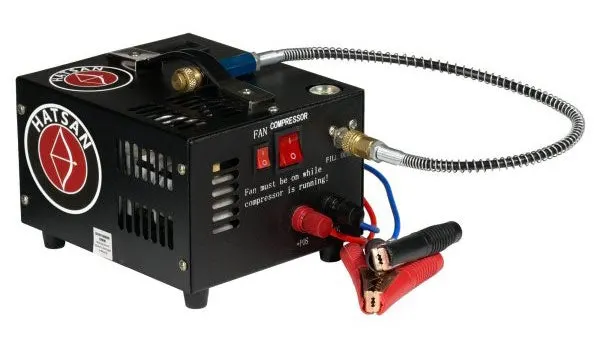
Hatsan TactAir Spark Portable Compressor is a great and affordable choice for filling the tanks of PCP guns. Hatsan
Unlike tradition firearms that all use some form of combustion to propel a bullet, there are quite a few different methods employed in air guns. All use pressurized air, of course, but the source of that air differs. The earliest air guns used a separate reservoir that was pumped up by hand to provide multiple shots, but as time went on, faster methods were developed using springs and then canned, compressed gas. Now, it seems that things are coming full circle, as air guns utilizing external reservoirs are the next big thing. Here’s a look at each five different methods of propulsion.
Pump Air Guns

Many folks started out with pump gun like the Crosman 760B Pumpmaster. Crosman
This is one of the most recognizable air gun types. Load a BB, pump the forend a number of times, take aim, and shoot. These models have a piston that is actuated by the forend, forcing air into a cylinder fitted with a check valve that won’t let it out. The more you pump, the more the air in the cylinder is compressed, and the more power is produced, though they usually top out around 500 fps. Pulling the trigger opens the cylinder, which dumps its contents into the chamber and pushes the pellet out the barrel. These make great introductory air guns, but the lack of power produced relegates them to plinking use.
CO2 Air Guns
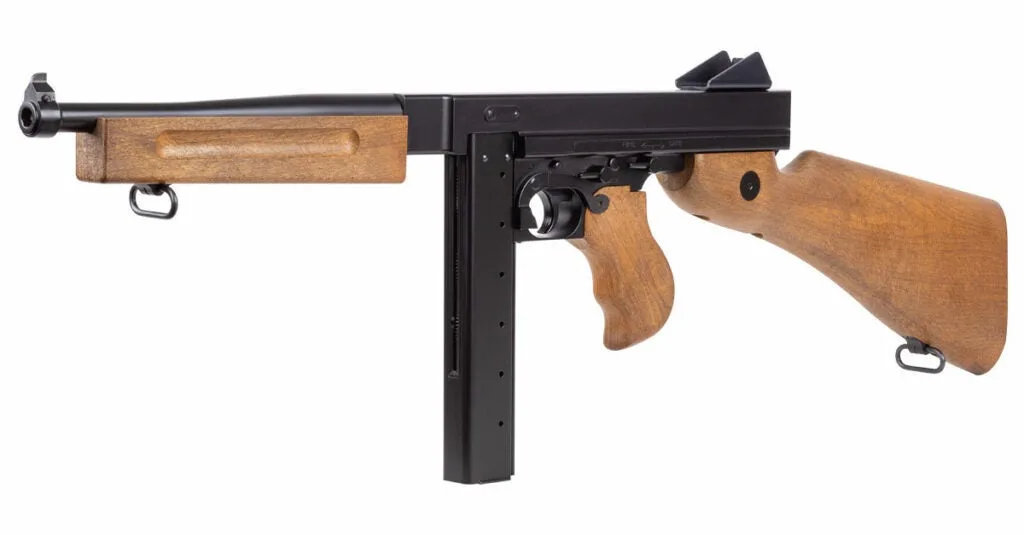
The Umarex Legends M1A1 BB Rifle is the spitting image of the Thompson submachine gun, with a similar rate of fire. The twin 12-gram CO2 cartridges let the replica empty the 30-BB magazine in flash. Umarex
Though we think of carbon dioxide as a gas, it is converted to a liquid under extreme pressure—like the inside of a CO2 cartridge. In this unique environment, CO2 exists in both liquid and gaseous states, with a third of the space occupied by the liquid and the remaining room allowing for conversion back to gas. In practical terms, this means that as more space becomes available, say by shooting a pellet, more transforms into gas and maintains the pressure. This provides fast action in an air gun, letting you plink until the cylinder is almost empty and pellets start to lose speed. Then you just swap the cartridge out and get right back to it.
Carbon dioxide is also denser than compressed air, so you can get more shots out of the same size container. But it’s far from a perfect system, as CO2 is greatly affected by temperature. Carbon dioxide needs heat to jump from liquid to gas, so you’ll get more shots on a hot day. If it’s really cold, CO2 may simply stay liquid, rendering your pellet gun all but useless. Traditional 12-gram cartridges are good for anywhere from 30 to 200 shots, depending on gun and temperature. The recent introduction of large 88-gram CO2 cylinders have extended that. You can even find full-auto CO2 repeaters that make use of the increased volume. Speeds and energy tends to be low, so CO2 guns are mostly dedicated to pinking, with few exceptions.
Spring Powered Air Guns

The Daisy Red Ryder is still produced and as popular as ever. Daisy
The iconic Red Ryder uses a spring for propulsion. Working the lever pulls the internal piston back, which compresses a coiled spring and forces the piston into the sear, where it stays until the trigger is pulled. Once the trigger is depressed, the stored energy in the spring is released, and the piston compresses the air behind the BB, pushing it out the barrel at about 350 feet per second.
The relatively small size of the spring limits the potential of the Red Ryder, but air guns equipped with larger springs can move pellets at speeds around 1,500 fps. Most of these use the barrel to cock the gun, needing the leverage it provides to load the powerful springs. The most powerful examples will employ a separate side or under lever to cock them, as the barrel would become warped under the strain of the large springs.
Spring-powered air guns can produce a lot of power, but have several downsides that just can’t be avoided. Springs get work-hardened over time and lose their effectiveness, producing less power with each passing shot. They also can’t be left cocked for long periods of time, as this rapidly ages the spring.
The advantage of spring-powered air guns is their self-contained nature, requiring no disposable cartridges or filling equipment to operate. As a plinker, or an entry-level hunting gun, it’s pretty hard to beat a springer. Just note that they can be a bit loud for an airgun, as the spring creates a fair amount of noise when the tension is released.
Gas Piston Air Guns
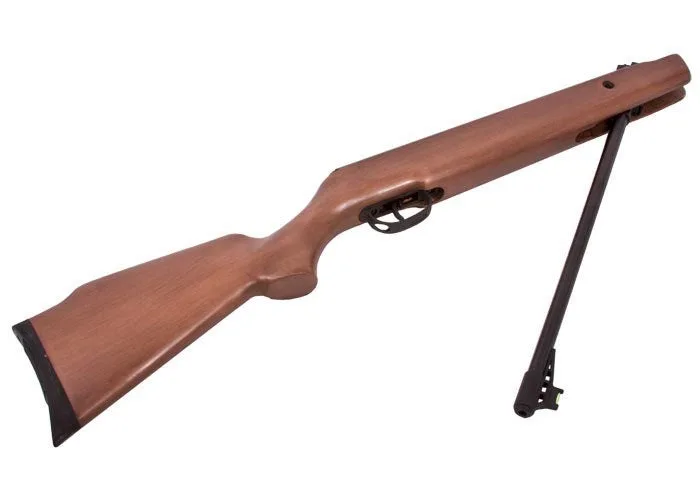
The Crosman Vantage Nitro Piston is an excellent, introductory gas piston air rifle. Crosman
Gas piston air guns were invented to defeat the shortcomings or spring-powered guns. Instead of a long spring, a piston is compressed inside a cylinder, similar in design to the struts on your car, containing an inert gas such as nitrogen. The ram is held under tension until the trigger is pulled, and then it pushes the column of air between it and the pellet and sends it downrange. Like springers, these guns are stand-alone affairs not requiring any additional hardware to work. They tend to be quieter, as the piston doesn’t make as much noise when it accelerates forward. There’s also less recoil, lacking the vibrations created by a spring. Unlike CO2 guns, there are no issues with temperature as inert gas doesn’t expand and contract nearly as much with extreme swings. These make great entry-level hunting air guns, but because they can only reach around 1,000 fps out of a .22 caliber pellet, they are limited in what game they can reliably take down.
Precharged Pneumatic Air Guns

The AirForce Texan in .457 caliber is a modern version of the Girandoni air rifle. With a couple hundred years of development, it functions a lot more reliably than its predecessor. AirForce Air Guns
Precharged pneumatics, commonly known as PCP, air guns are one of the fastest growing segments of the air gun world. Simply put, these guns use air compressed to extreme pressures to propel pellets at velocities approaching centerfire territory. You can find PCPs in calibers from .177 all the way up to .51-caliber big bores capable of dropping Cape Buffalo. Though the premise remains the same, they’ve come a long way since the days of Lewis and Clark. Perhaps the only real downside to PCP guns is the accessories needed to keep them functional, as they require a way to fill the tank to somewhere around 2,500 to 4,000 psi for successful operation. The most common method is to use a scuba tank, or a carbon fiber one purpose-built for the task.
As PCP technology has become more popular, compressors capable of delivering the extreme pressures needed are becoming more commonplace, but you can expect to spend as much, or more, on these as a quality rifle. The hand pump of yore is a viable option, though these obviously require some effort. Once you’ve made the initial investment into a scuba tank or other filling method, obtaining additional rifles becomes relatively inexpensive, so you can take everything from squirrels to whitetails with your arsenal.
Air Gun Recoil
You’re probably thinking that air guns don’t recoil, but that’s not exactly true. Newton’s Third Law states that to every action there is an equal and opposite reaction. In the case of an 8-grain pellet being pushed by a 350 fps gust of air, recoil is just about non-existent. But as the weight of the projectile increases, so does recoil, and powerful PCPs can have a kick similar to a .22 rimfire or even greater in the big bores.
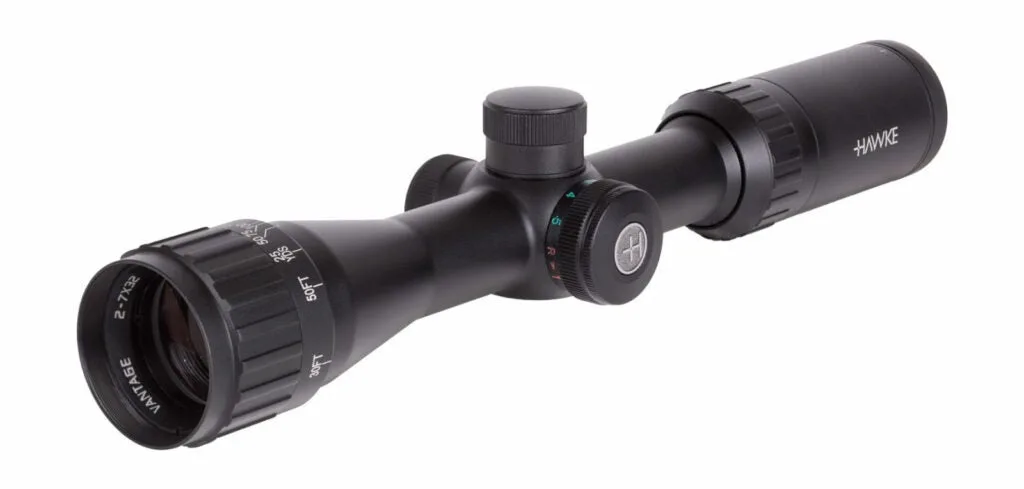
Hawke Sport Optics HD IR Series 2-7×32 AO Rifle Scope is built to handle the two-way recoil of spring- or gas-piston air gun. Hawke Sport
Spring-powered airguns have a two-way recoil impulse, owing to the separate movements of the spring and the piston. Once fired, the springer lurches forward, but then jerks backwards as the piston reaches the end of its forward travels and abruptly stops. Gas-piston guns exhibit a similar action, but the inert gas offers a bit of a cushioning effect. This will have little effect on you, but can wreak havoc on the sensitive internals of optics. Make sure you select an air gun scope specially designed to withstand the two-stage recoil produced by spring-powered guns. And keep an eye on it, as the mounts are known to walk on the 11mm dovetail traditionally found on airguns.


